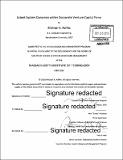Latent system dynamics within corporate venture capital firms
Author(s)
Rolfes, Michael A. (Michael Andrew)
DownloadFull printable version (7.692Mb)
Other Contributors
Massachusetts Institute of Technology. Engineering Systems Division.
Advisor
Alex "Sandy" Pentland.
Terms of use
Metadata
Show full item recordAbstract
At the current pace and scale of sociotechnical progress, incumbent firms must seek out alternatives to traditional R&D in order to protect their current market position. By deploying corporate venture capital, many firms have leveraged the nimble, resourceful, and efficient nature of start-ups to inject compelling innovations into their core business lines. However, this arrangement must be constructed and cultivated carefully in order to optimize potential returns. Technological product or platform integration must be planned and executed, and value networks should be interleaved wherever possible. This paper asserts that the most effective corporate VCs have adopted these distinct practices, and further contends that these CVCs should view investment funding as a cost of doing business (rather than seeking long shot returns). These investors are inherently directing cash flow to an agile development workforce riding at the forefront of trends and technology, over which they maintain some level of strategic control. A series of interviews were conducted in order to capture the direct and indirect objectives, philosophies, and operations of corporate venture capital firms. Rather than simply validating or refuting the above hypotheses, this paper also qualitatively examines the insights and implications of the respondent data. Through the course of the analysis, numerous operational coherency issues were discovered, which are explored and discussed using principles from system dynamics, innovation theory, and management literature. Historical evidence and outside empirical studies were also leveraged to further highlight and underscore some of these key discoveries.
Description
Thesis: S.M. in Engineering and Management, Massachusetts Institute of Technology, School of Engineering, System Design and Management Program, Engineering and Management Program, 2016. Cataloged from PDF version of thesis. Includes bibliographical references (pages 62-63).
Date issued
2016Department
Massachusetts Institute of Technology. Engineering and Management Program; System Design and Management Program.Publisher
Massachusetts Institute of Technology
Keywords
Engineering and Management Program., System Design and Management Program., Engineering Systems Division.